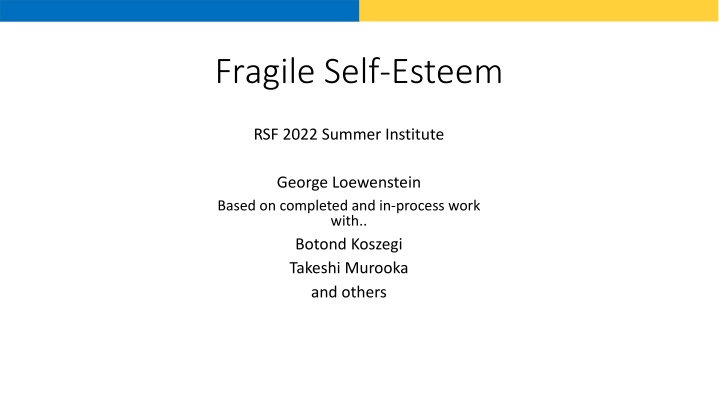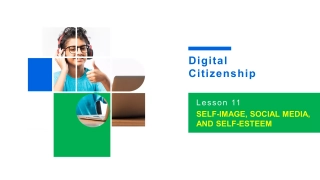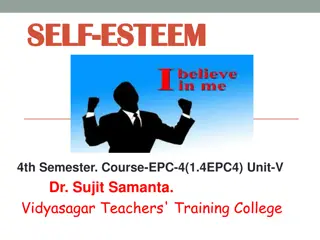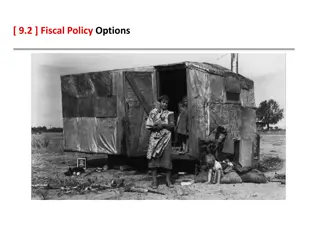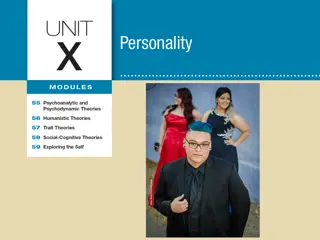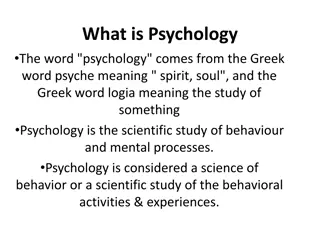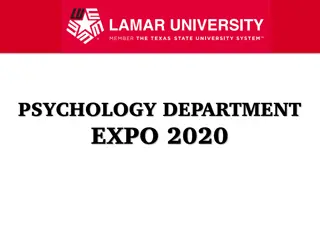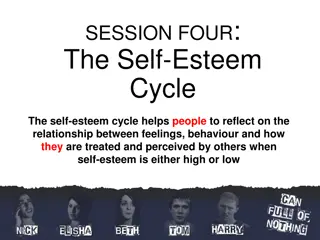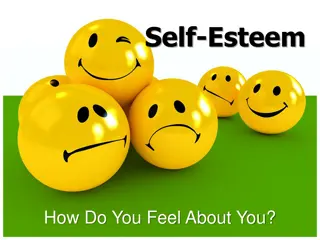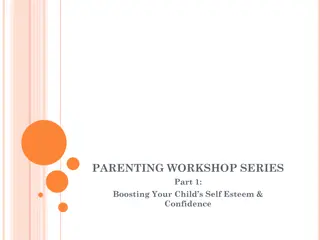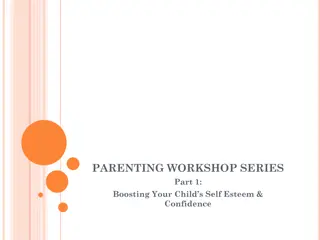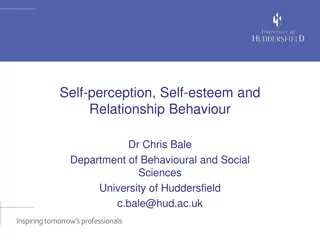Fragile Self-Esteem: Exploring Connections Between Psychology and Economics
Fragile self-esteem is a common but complex phenomenon that impacts individuals' emotions and behaviors. This paper delves into the interplay between psychology and economics to understand the implications of high-but-fragile self-esteem, especially in terms of insecurity and narcissistic traits. Drawing on research by experts like George Loewenstein, Botond Koszegi, and Takeshi Murooka, it explores how individuals with this type of self-esteem may exhibit defensive behaviors, lower psychological well-being, and a greater need for validation. The study sheds light on the intricate relationship between self-perception, behavior, and societal norms.
Download Presentation

Please find below an Image/Link to download the presentation.
The content on the website is provided AS IS for your information and personal use only. It may not be sold, licensed, or shared on other websites without obtaining consent from the author.If you encounter any issues during the download, it is possible that the publisher has removed the file from their server.
You are allowed to download the files provided on this website for personal or commercial use, subject to the condition that they are used lawfully. All files are the property of their respective owners.
The content on the website is provided AS IS for your information and personal use only. It may not be sold, licensed, or shared on other websites without obtaining consent from the author.
E N D
Presentation Transcript
Fragile Self-Esteem RSF 2022 Summer Institute George Loewenstein Based on completed and in-process work with.. Botond Koszegi Takeshi Murooka and others
Large body of research and theorizing in psychology and economics assumes that people care about their social, and self-image For what purpose is all the toil and bustle of this world? what is the end of avarice and ambition, of the pursuit of wealth, of power, and preeminence? Is it to supply the necessities of nature? .. To be observed, to be attended to, to be taken notice of with sympathy, complacency, and approbation, are all the advantages which we can propose to derive from it. It is the vanity, not the ease, or the pleasure, which interests us. Jeremy Bentham, Introduction to Principles of Morals and Legislation Adam Smith, Theory of Moral Sentiments Leary, M. R., & Baumeister, R. F. (2000). The nature and function of self-esteem: Sociometer theory. In Advances in experimental social psychology (Vol. 32, pp. 1-62). Academic Press. Brennan, G., & Pettit, P. (2004). The economy of esteem: An essay on civil and political society. Oxford University Press, USA.
Focus of paper: fragile self-esteem insecurity Emotional insecurity or simply insecurity is a feeling of general unease or nervousness that may be triggered by perceiving of oneself to be vulnerable or inferior in some way, or a sense of vulnerability or instability which threatens one's self-image or ego. Closely related to distinction between explicit and implicit self-esteem Pervasive across people (though differences in extremity) Most interesting and important situation: High-but-fragile self-esteem Takes extreme form in, and is an identifying feature of, narcissistic personality disorder Koszegi, Loewenstein, Murooka, T. (2021). Fragile self-esteem. Review of Economic Studies. Loewenstein, , Koszegi & Murooka (in process). Insecurity. (paper aimed at psychology journal)
Research by psychologists has identified diverse consequences of high-but-fragile self-esteem Kernis (2001) reports that among high self-esteem individuals, the more unstable their self-esteem.. a) the greater their anger and hostility proneness; b) the more severe their depressive symptoms, and the lower they score on various dimensions of psychological well-being; c) the more defensively they react to perceived transgressions; d) the more they engage in self-handicapping (i.e., introducing obstacles to their own success) e) The more boastful they are
Some personal observations (including from biographies).. Many of the most successful academics seem to embody a combination of hubris and insecurity they have to have something to prove Many biographies of prominent individuals reveal a similar pattern e.g., His relentless drive, his wretched feelings of shame and degradation, and his precocious self-sufficiency combined to produce a young man with an insatiable craving for success. (Ron Chernow, Alexander Hamilton) The blow to his self esteem [from being rejected at the academy of art] had been profound. And the bitterness showed.. He would fly off the handle at the slightest thing. His loss of self confidence could flare up in an instant into boundless anger and violent denunciation of all who he thought were persecuting him. (Ian Kershaw, Hitler) Henry Kissinger grew up with that odd mix of ego and insecurity that comes from being the smartest kid in the class. From really knowing you're more awesomely intelligent than anybody else, but also being the guy who got beaten up for being Jewish (Walter Isaacson, Kissinger). For all his accomplishments, the 37th president (Nixon) was a man of deep contradictions: a law-and-order candidate who flouted the law, an insecure man with a deep reservoir of hubris. (Brinkley, review of Graff, Watergate: A new History) Insecurity (e.g., jealousy) has a nasty tendency to be self-fulfilling
What does it mean for self-esteem to be fragile/insecure? A wrong answer: that it is variable In fact, in people with high but fragile self-esteem, there is a big downside risk, but little upside potential E.g., according to Baumeister (1997), violence and cruelty arise from people who.. think well of themselves most of the time but who are vulnerable to frequent or large fluctuations in their self-esteem. For these people, that miserable sinking feeling that goes with a drop in self-esteem is all too familiar, and they are on guard to avoid it. Even a slight hint or mild implication that questions their personal worth may elicit a strong response."
Why would self-esteem be subject to asymmetric shifts? A clue: People with Rejection Sensitivity have such a strong emotional reaction to negative judgments, exclusion, or criticism from others that it sends them into a mental tailspin (Bonior, 2019). Airplanes go into tailspins as a result of self-reinforcing feedback; our argument is that self-esteem can also go into tailspins as a result of self- reinforcing feedback. We argue that self-esteem generates feedback that establishes the possibility of multiple self-esteem personal equilibria (SEPs). An individual at a high SEP will be afraid of the possibility of dropping to a low SEP, entailing a potentially catastrophic drop in self-esteem K szegi, B., & Rabin, M. (2006). A model of reference-dependent preferences. The Quarterly Journal of Economics, 121(4), 1133-1165. K szegi, B. (2010). Utility from anticipation and personal equilibrium. Economic Theory, 44(3), 415-444.
Crux of the (economic) model: mood-contingent memory Individual has a store of ego-relevant memories Recall of these memories depends on mood, which depends on self-esteem as a result of mood-contingent memory self-esteem mood memories recalled But, what memories one recalls also affects self-esteem memories recalled self-esteem Possibility of multiple self-esteem personal equilibria (SEPs) at which a level of self- esteem evokes memories that support it e.g., Feeling good about oneself and recalling memories of events that make one feel good about oneself Feeling bad about oneself and recalling memories that make one feel bad In the version of the paper aimed at psychology, we discuss a wider range of feedback processes that can have similar effects e.g., Effects of self-esteem/confidence on performance (and vice-versa) Effects of self-esteem/confidence on other people s reactions to one (and vice-versa)
SEP (self-esteem personal equilibrium): Example with simple recall function Definitions: A level of self-esteem, ? is a SEP if it is a locally stable solution to the equation ? = ?[?? ?] A person has fragile self- esteem if there are multiple SEPs Assumptions: Agent understands that there might be multiple SEPs (e.g., at low fragile SEP, realizes that there is also a high SEP) However, this realization does not change his self-esteem
The impact of the strength of the feedback function When feedback effects are weak, there will be only one equilibrium, and the agent will assess his own ability accurately When feedback effects are strong there will be multiple equilibria When there are multiple equilibria, the agent will either be over-confident (if at high SEP) or under-confident (if at low SEP), but not accurately calibrated (connection to over- confidence and the impostor syndrome ). People will either work too hard (because they are overconfident and anxious not to perturb a high SEP) or insufficiently hard (because they are under-confident)
Implications.. Which SEP the individual ends up at, will depend on where he begins which side of the unstable equilibrium-point Perturbations that drive him over the unstable equilibrium will lead to a massive change in self-esteem (and mood) I have observed in myself, so often that it no longer surprises me, that if I give a performance before some audience I am jollier at dinner, and eat more, if I am pleased with my performance. Disagreeable feedback spoils the evening. At my age the statistical record of my performance ought to reflect so many observations of good, poor, and mediocre performance that one more experience at either tail of the distribution could hardly affect a rational self-assessment. I try to remind myself that on those occasions when feedback depresses me; but my welfare function is apparently not constructed that way. Thomas Schelling, The Mind as a Consuming Organ, 1988 An interesting prediction from this framework is that an individual at a high SEP can slough off a certain amount of bad news, but too much bad news at once will drive him to a low SEP Surprisingly, we were unable to locate a test of this intuitive prediction in the psychology literature.
Implications.. Differences in ability tend to affect the unstable cross-over point more than they affect the location of SEPs People with low abilities will have unstable high SEPs and very stable low SEPs The fragility of an individual s SEP can be diagnostic of their ability, even when the level of their SEP (self-esteem is not)
Multiple domains of self-esteem Diversification can provide protection against ego-drops But hits to ego in one domain can spill over into other domains
Information avoidance Traditional economic models don t predict information-avoidance Belief-based utility models can (by assuming concave utility of beliefs) But, such models predict that people will only be weakly information-avoidant, and avoidant across-the board Current model can make sense of very strong information avoidance: fear of dropping to a low SEP Predicts domains in which it will occur those in which the individual has fragile self- esteem, in which ego is very important, and in which self-esteem is highly reference- dependent
Self-handicapping (putting obstacles in the way of success to muddy signals from failure) Self-handicapping is a special form of information avoidance Most economic models have trouble explaining self-handicapping because individuals have a huge store of ego-relevant information Current model can explain why an individual would be highly averse to getting one piece of negative ego-related information and might avoid situations in which such information could arrive because one piece of negative information can have a huge impact if it perturbs a high SEP Helps to explain the structure of most self-handicapping experiments: Individuals are given feedback on task performance that is better than they anticipate creating insecurity about whether a good performance is likely to be repeated Given the opportunity to undermine themselves to avoid getting more feedback One example of how insecurity is self-fulfilling
Education.. Dominant theories of under-investment in education attribute it to lack of information or present-bias But informational interventions and immediate rewards (which should be effective given present-bias) have been found to be largely ineffective Our framework implicates under-confidence as a likely cause Can also help make sense of: the documented consequences of a fixed versus growth mindset Why students who are afraid of failure might identify their ego with non-academic activities Students who perform poorly but who manage to cling to a high SEP are those most likely to self-handicap e.g., choose classes/topics that are extremely easy or extremely difficult, or introduce barriers to their own success e.g., drugs, alcohol, not studying
Workaholism/professional success.. Term workaholism coined in a 1968 confessional essay by Wayne Oates (who authored 57 books) Oats and other psychologists see workaholism see it as a disorder with components that overlap with addiction e.g., working beyond what is reasonably expected of the worker, despite the potential for negative consequences (e.g., marital issues) (Clark, 2016) Our model interprets workaholism as a manifestation of a high but fragile SEP. Predicts that workaholics will be especially likely to be low in ability Explains why workaholics tend to score high on narcissism (which is currently the best measure of high but fragile self-esteem)
Job search Lots of research shows that unemployment is a highly aversive state (e.g., Lucas, Clark, Georgellis & Diener, 2004). Surprisingly, however, studies of job search (e.g., Krueger & Mueller, 2010) find that people spend remarkably little time on job search (the U.S. is the highest in an international comparison, at half an hour a day) Most unemployed are probably at low SEP, in which case they will under-invest in job-search due to under-confidence Those at high SEPs might be expected to search a lot, but they might be anxious to preserve a fragile high SEP, and search could result in rejection.. Implications for the kinds of search activities that job-seekers engage in -- i.e., those that don t expose them to the risk of explicit rejection)
Aggression People at high but fragile SEPs are, in-effect, walking on the top of a wall; they have high self- esteem, but minor challenges to self-esteem can potentially topple them Aggression, in this view, represents an attempt to silence those who threaten one s self-esteem The more unrealistic is the agent's high self-esteem, the more fragile it is, and hence the smaller is the slight that triggers a response, and the stronger is the reaction The plethora of adages such as They who Threaten are afraid" (Diary of Benjamin Franklin) and All Cruelty Springs from Weakness" (Seneca) point to the ubiquity of the phenomenon. Lots of supportive evidence e.g., Berkowitz s (1978) study of violent criminals failed to find support for the prediction it tested, but instead concluded that the men were ``quick to see themselves as challenged and frequently interpreted someone else's remarks as belittling them,'' which ``often infuriated'' them and ``stimulated them to lash out impulsively.' Narcissism (an indicator for high fragile self-esteem) is commonly associated with anger and aggression
Trauma Theory can help to explain why one, often quite brief, experience can have such a major impact on well-being and functioning Conventional economic model simply views trauma as a very bad but short-lived experience Conventional psychological model adds that trauma is stored as a memory that can be recalled intrusively Current model adds idea that trauma is likely to both lower low SEP and also make it more likely to get triggered
Many other psychological phenomena e.g., Rejection sensitivity.. Individuals who have this condition respond extremely negatively to the perception of being rejected: It goes far beyond the run-of-the-mill discomfort that most of us experience.. They feel like failures, disproportionate to what has actually occurred. They may feel rage and want to lash out. They often exaggerate how people are against them, or how much people dislike them, or they carry long-term shame (Bonior, 2019). Leary and Baumeister s (2000) sociometer theory of self-esteem posits that self-esteem.. Performs the essential job of monitoring and reacting to social acceptance and rejection We posit that rejection-sensitive individuals are just at the extreme of this form of sensitivity Failures to apologize Apologizing is so simple, yet enormously consequential; yet people often fail to do so (Chaudhry & Loewenstein, 2020) Why can some people never admit they ve misstepped, .. Even when they re obviously in the wrong? For these people, admitting wrongdoing and offering an apology is too psychologically threatening. Offering an apology implies that they ve harmed another person in some way, which can elicit feelings of shame. People who cannot apologize often have such deep feelings of low self-worth that their fragile egos cannot absorb the blow of admitting they were wrong (Winch, 2021).
Gender differences Diverse research in psychology and economics document robust differences between males and females in aggression, risk-taking, health behaviors, educational aspirations and attainments, and political attitudes. New vein research connects all of these differences to the notion of precarious masculinity, in which manhood (unlike womanhood) is seen as a social state that requires continual proof and validation (Bosson and Vandello, 2011). E.g., proverbs expressing themes about the precariousness of either manhood or womanhood e.g., Manhood is hard won and easily lost are more endorsed, liked, and understood than comparable womanhood proverbs ( Womanhood is hard won and easily lost ) (Vandello et al., 2008). Other research links fragile manhood (with obvious links to fragile self-esteem)to each of the gender differences enumerated above. E.g., Bosson et al. (2009) threatened some men s manhood by having them perform a conventionally feminine hair-braiding task, while other men braided rope. Men whose manhood had been threatened by braiding hair were more likely to choose to hit a bunching bag relative to solving a puzzle, and punched more aggressively More likely to gamble and opt for an immediate payoff Fragile self-esteem has also been linked to health behaviors, gender differences in educational aspirations and attainments, and support for extremist politicians
Conclusions: Research on attention In addition to its focus on ego, paper is also example of new research on attention. Sims (2003), Caplin et al. (2020): Models of rational inattention Camerer & Johnson (2004), Johnson, Camerer, Sen & Rymon, 2002; Crawford (2008); Crawford, Cost-Gomes & Iriberri (2006): Process-tracing studies of attention in economic games Gabaix, Laibson (2006), Gabaix (2014): Model of how firms use "shrouded attributes" to profit from limited consumer attention Chetty, Looney, Kroft (2009): Demonstrate that not all taxes are equally salient, and model this in terms of limited attention. Lacetera, Pope, Sydnor (2011): Demonstrate limited attention using car price data. Schwartzstein (2014): Connects selective attention to a variety of behavioral biases. My own focus on attention: Paper (with Edika Quspe-Torreblana, John Gathergood and Neil Stewart) documenting attention avoidance, and arguing that many phenomena that have been classified as information avoidance are actually attention-avoidance JEL review of attention in economics (with Zach Wojtowicz) arguing that attention should be treated as a key scarce resource in economics, on a par with land, labor, capital Set of projects (also with Zach) examining the role of motivational feeling states associated with thinking e.g., boredom and mental effort in allocating attention efficiently
Conclusions We all know that ego is hugely important very likely more important than consumption, for most people We (behavioral researchers) have only scratched the surface when it comes to modeling the implications of this insight More generally, we have only started to exploit the possible gains from trade between economics and psychology Behavioral researchers should expand the range of psychological phenomena we incorporate into our models Tools/perspective of economics can help to formalize ideas from psychology to generate new insights and predictions
